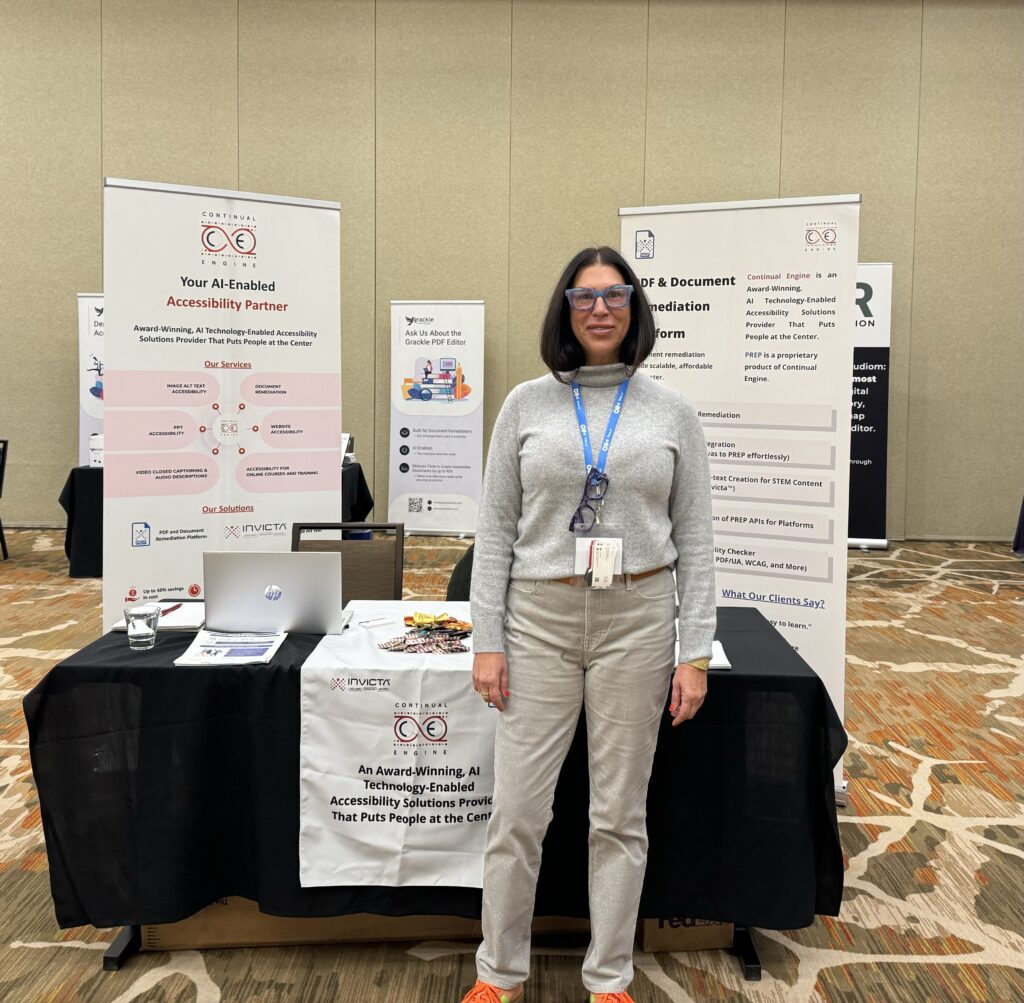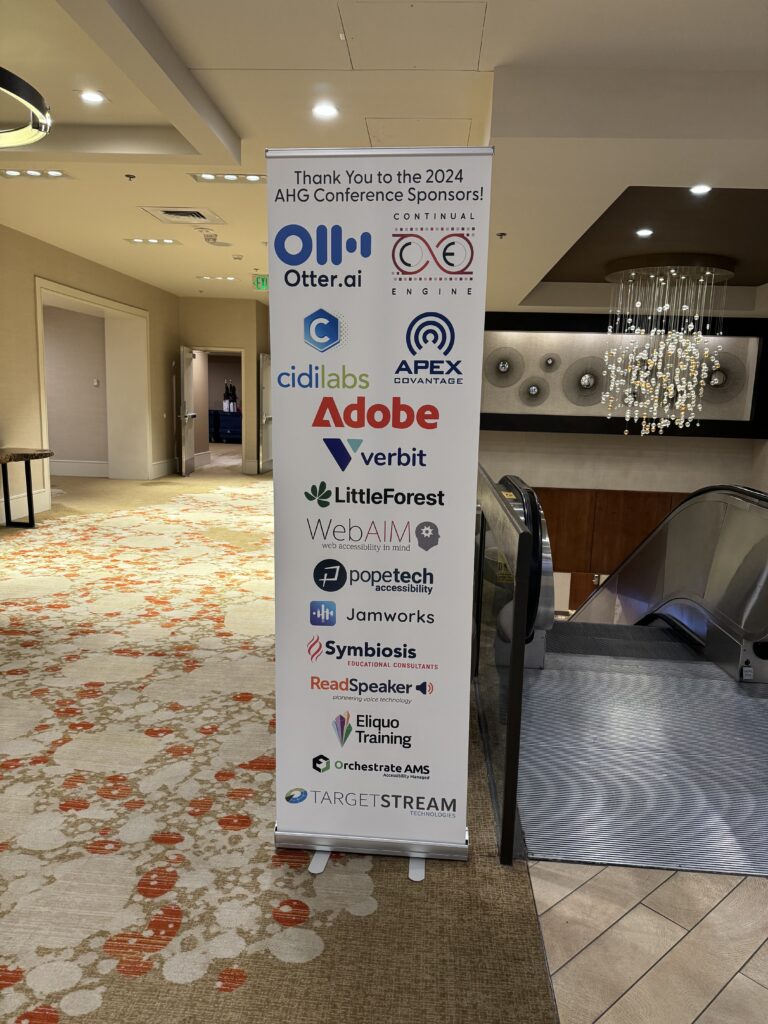Dear Valued Readers,
Wishing you a season of gratitude and joy—Happy Thanksgiving! We invite you to explore the latest updates in accessibility and AI with Continual Engine’s November Newsletter. This edition brings you a curated collection of articles and insights, to keep you updated on the latest trends and innovations. Stay informed, stay inspired!
- Latest AI Updates For Digital Accessibility: Introducing PREP+: Reshaping Document Accessibility and Compliance
- Gain Insights from our Latest Blog on Accessibility: How AI is Transforming Captioning and How We Can Improve Transcription Quality
- Past Events Include: Continual Engine Presentation and Exhibition at the AHG Conference 2024
- Latest Advancements in Accessibility Include: Uber Enhances Features to Improve Accessibility
- Discover the Latest News Articles that Include: WCAG2ICT Guidance: Applying WCAG to Non-Web ICT, AI in Governance: Generative AI Enhances Accessibility, Accessible Maps: Maps for Screen Readers, European Accessibility Act: Compliance Countdown Begins, Descriptive Transcripts: Promoting Inclusive Communication, New York Jobs Training: Accessibility in Energy Transition, Holiday Sales Boost: Accessibility Drives Growth, AI Challenges: Bias in Accessibility Tech, Accessibility Norms: SC Pushes Mandatory Standards, Google Calendar Updates: Improved Accessibility Features, Nestlé QR Codes: Supporting Visually Impaired Consumers, Colorblind Maps: Accessible Solutions for Scientists, Ride-Sharing Protests: Accessibility for Blind Passengers, and AI & Food Compliance: Meeting Deforestation Rules.
We aim to bring you engaging, insightful, and relevant updates on accessibility and compliance through these newsletters. We welcome any feedback or questions.
Warm Regards, Continual Engine
I. AI UPDATES FOR DIGITAL ACCESSIBILITY
Continual Engine has introduced a groundbreaking solution in document accessibility – PREP+. It can be seamlessly integrated into your existing software or current workflow, to detect and correct accessibility issues in your documents. With PREP+, you can ensure compliance with global accessibility standards like WCAG and PDF/UA with just one click, making document accessibility simpler, faster, and more cost-effective.
II. LATEST BLOGS ON ACCESSIBILITY
In the business world today, the accuracy of transcriptions is difficult to maintain. Improving the way you document everything and keep it high quality is important. It improves the accessibility of your content and saves you time as well.
III. PAST EVENT
1. Continual Engine Presented and Exhibited at the AHG Conference 2024
Continual Engine recently participated in the 27th Annual Accessing Higher Ground Conference 2024. As part of the conference, we presented a session on PREP – our PDF & Document Remediation Platform, highlighting how it is transforming document accessibility with cutting-edge automation. We provided insights on trends in PDF accessibility, drawing from conversations with a diverse range of educational institutions, both large and small.

This year marks our 7th consecutive year at the conference, reinforcing our commitment to driving innovation and accessibility in the education sector. Each year, we look forward to connecting with industry leaders, institutions, and peers to share knowledge and learn from one another.

We are grateful to everyone who stopped by our booth or joined our session—it was your participation that made the event truly enriching! If you have any questions or are interested in exploring our end-to-end digital accessibility solutions and services, feel free to reach out at contact@continualengine.com.
IV. ADVANCEMENTS IN ACCESSIBILITY:
Uber is rolling out new features to assist riders with disabilities and is adding training for drivers to help better accommodate them. The ride-sharing company said this month that it will offer riders who are deaf or hard of hearing as well as those who are blind or who have low vision the option to self-identify on the app and set communication preferences.
V. NEWS ARTICLES ON ACCESSIBILITY
1. Guidance on Applying WCAG 2 to Non-Web Information and Communications Technologies (WCAG2ICT)
This document, “Guidance on Applying WCAG 2 to Non-Web Information and Communications Technologies (WCAG2ICT)” describes how the Web Content Accessibility Guidelines (WCAG) versions 2.0 [WCAG20], 2.1 [WCAG21], and 2.2 [WCAG22] principles, guidelines, and success criteria can be applied to non-web Information and Communications Technologies (ICT), specifically to non-web documents and software. It provides informative guidance (guidance that is not normative and does not set requirements).
2. Inclusive Governance: How Generative AI is Making Public Services Accessible to All
While the public sector continues to evolve with advancing technology, its core objective remains unchanged: ensuring that all citizens, regardless of socio-economic status, physical abilities, or geographic location, have equal access to public services. This objective, commonly known as inclusive governance, has led the sector to continually embrace advanced technologies to improve citizen engagement, streamline operations, and make informed decisions.
3. Making Maps Accessible to Screen Readers
Maps are visual by nature. But have you ever listened to your map? Imagine that was the only way you could understand a map. Recently, the State of Minnesota’s State Agency GIS Collaborative gave a presentation to state employees about listening to your maps and provided resources from the State’s Accessible Maps Community of Practice (CoP) group.
4. The European Accessibility Act: 10 Months and Counting
Without sounding dramatic, the countdown to the European Accessibility Act (EAA) is on. This major piece of legislation will impact organizations across multiple sectors that have operations in the EU or sell to customers in the EU. Its first deadline that could impact your organization is on 28th June 2025 – so will your organization be ready?
5. Advancing Inclusive Communication: Haben Girma on Descriptive Transcripts
In this episode of the United in Accessibility podcast, Haben Girma discusses the significance of descriptive transcripts in enhancing digital accessibility for diverse audiences. She emphasizes that these transcripts provide richer context and detail beyond traditional captions and audio descriptions, fostering inclusive communication and bridging cultural gaps in media consumption.
6. How New York’s Inclusive Approach to Jobs Training is Building Stronger Foundations for The Energy Transition
Just over two years ago President Joe Biden signed the Inflation Reduction Act into law, which was designed to boost the green economy through sustainable infrastructure projects across the country. The IRA’s Justice 40 provision set a goal that 40% of the overall benefits from the IRA flow to communities that “are marginalized and overburdened by pollution”.
7. How Digital Accessibility Can Increase Holiday Sales and Impact Future Growth
As the holiday shopping season approaches, retailers often focus on increasing sales by boosting website traffic and optimizing user experiences. However, one often overlooked critical growth lever is digital accessibility, which ensures websites and digital content are accessible to people with disabilities who may use assistive technology to access the internet.
8. AI Can Make Sets More Accessible, But The Tech Still Reflects Ableist Bias, Experts Warn
AI can make Hollywood sets more accessible for people with disabilities, but it still has no idea how to replicate diversity on screen or in its output, experts and advocates said at TheWrap’s Grill conference this week. “AI is not intelligence. It’s mimicking intelligence,” Candis Welch, the Chief Equity Officer for California’s Department of Rehabilitation, said. “It’s mimicking what our society is putting in. So if our society … has ableism and different levels of discrimination, it’s not going to produce something different when you type it into ChatGPT, or whatever you may use.”
9. Center Must Establish Mandatory Accessibility Norms for People with Special Abilities: SC
The Supreme Court on Friday directed the Centre to implement mandatory accessibility standards within three months, in a significant order aimed at improving access to public spaces for persons with disabilities. The order by a three-judge bench headed by Chief Justice D Y Chandrachud comes in response to slow progress on the accessibility directives issued by the court in a judgment on December 15, 2017
10. New Design and Accessibility Improvements for Embedded Google Calendars
Users currently have the ability to add an interactive version of their Google Calendar to their website and add buttons for their website visitors to save their calendar events.
11. Nestlé Moves to Assist Consumers with Sight Loss in Forging Accessible QR Codes
A notable move to assist consumers with sight loss has been made by Nestlé Confectionery, which is trialing Accessible QR codes for its flagship KitKat and Quality Street, which will enable greater ease of access for customers, writes Neill Barston. The two core brands have remained firm favorites with shoppers among all age groups, with the business recently reporting strong sales across its chocolate portfolio, which has also focused increasingly on sustainable sourcing and recyclable packaging measures.
12. A Visionary Approach: How a Team Developed Accessible Maps for Colorblind Scientists
Imagine having to do your job, but not being able to visually process the data right in front of you. Nearly 8% of genetic males and 0.5% of genetic females have some form of Color Vision Deficiency (CVD), or a decreased ability to discern between particular colors. CVD is commonly referred to as color blindness.
13. San Francisco Rallies Against Ride-Sharing Apps’ Lack of Accessibility Provisions for Blind Passengers
People who are blind and their supporters rallied Tuesday against Uber and Lyft in San Francisco, claiming the ride-share apps discriminate against them. The National Federation of the Blind led Tuesday’s rally, and its members told NBC Bay Area they hope to draw more attention to what they say is the companies’ failure to stop discrimination against blind individuals, particularly those accompanied by guide dogs.
14. How AI Can Help The Food Sector to Meet New Deforestation Rules
The sustainability of food and beverage companies is under increasing legislative and public pressure. With forest destruction responsible for about 15% of total greenhouse gas emissions, opens a new tab, and agriculture driving 70-80% of deforestation, opens a new tab, the responsibility to act sits squarely with the sector.
